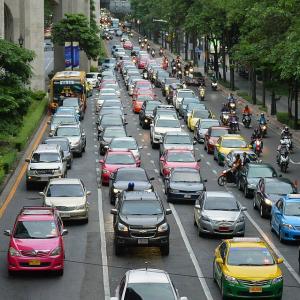- 13 reads

It might not surprise you to learn that the average urban commuter in the U.S. wastes about 42 hours a year in traffic jams. Though this may seem like an inevitable part of your day that equates to a mild annoyance, traffic congestion can have far reaching effects on the environment and public health. With more drivers on the road than ever, packed roadways and policies related to air and noise pollution struggle to keep up. Here are a few major impacts of traffic jams on the environment, our health, and our economy as well as a few ways we might lessen these effects moving forward.
Environmental Impacts
About one-third of the carbon dioxide emissions in the United States come from moving people or goods, and 80 percent of these are caused by cars and trucks. The constant starting and stopping caused by traffic jams burns significantly more fuel than vehicles would consume by travelling at a constant speed. This leads to higher amounts of carbon dioxide being released into the atmosphere, increasing our carbon footprint as a nation and speeding the process of global climate change. Traffic emissions also release nitrous oxide and other dangerous particulate matter that contaminates the air we breathe.
Effects on Public Health
According to a 2010 study by Harvard School of Public Health, air pollution from traffic congestion in some of the largest urban areas in the U.S. contributes to more than 2,200 premature deaths annually. This has particularly impacted mortality rates related to heart attacks and strokes as well as causing respiratory illnesses such as asthma. Due to an increase in low-emission vehicles on the road, this number has declined from 3,000 premature deaths in 2005. However, according to predictive models in the study, these rates are expected to begin rising again by 2030.
Another report suggests that heavy traffic also places significant health risks on the public in the form of noise pollution. The noise caused by traffic congestion has the immediate effects of annoying nearby residents and disturbing their sleep patterns. And while simply being annoyed may seem less serious, long-term exposure to noise pollution can lead to an increased risk of heart attacks, high blood pressure, insomnia, and other stress-related conditions.
Economic Costs
By using a value of statistical life approach, The Harvard School of Public Health reported that the health impacts of traffic congestion cost about $31 billion dollars in the U.S. in 2000. According to a report by INRIX and the Centre for Economics and Business Research, traffic congestion cost $124 billion worldwide in 2013. This included $78 billion in time and fuel wasted in traffic as well as $45 billion in indirect costs that businesses passed on to American consumers. These numbers reveal a shocking cost shared by people around the world.
Searching for Solutions
Possible solutions to traffic congestion include developing better methods for cities to track and plan for traffic patterns, converting to driverless cars, and charging drivers to access certain routes during peak times. Of these options, some say congestion pricing is one of the only strategies that will have a significant impact on traffic jams. While the program charging drivers to access busy streets in London has reduced the number of cars on the road, approaches like this are rare. The public has expressed mixed reviews about the program’s visible effects on the flow of traffic, and congestion pricing seems to be a political risk since the policy could appear to favor the wealthy.
A scenario in which self-driving cars completely replace traditional drivers could result in a more efficient traffic flow. It’s possible driverless cars would avoid the common errors that often result in a wave of slow-downs. However, there is also a likelihood that the convenience of driverless cars would increase the number of vehicles on the road and the overall number of miles travelled. And while a single driverless car could serve an entire household, it would burn more fuel going back and forth between destinations.
Even building additional and wider roads seems to have little effect on traffic congestion. When more road space is created, drivers who previously used alternate routes because of traffic issues will use the new roads, eventually building up to the point of overcrowding. So, aside from simply accepting traffic congestion, what can we do?
Practical Strategies for Individuals
In some cases, individual drivers can plan their routes to avoid traffic congestion. Drivers can use Google Maps to view current traffic conditions as well as predict typical traffic patterns in cities known for their busy rush hours like Portland, Oregon. Barring heavy traffic caused by a sudden accident, this could help drivers create regular strategies to adjust their commute. This might involve leaving sooner or later in order to avoid rush hour, or taking alternate routes that bypass the most dense areas. Either of these strategies could lessen an individual’s driving time as well as reduce emissions caused by cars in heavy traffic.
Using alternate forms of transportation can also save fuel and reduce overall vehicle emissions. This includes public transportation such as busses, subways, and carpooling services. Of course, if you have the option of walking or bicycling, you can avoid traffic jams altogether.
If you do get caught in heavy traffic, you can limit your vehicle’s emissions by accelerating and braking gently rather than revving your engine each time traffic moves. In a car with an automatic transmission, using a lower gear like D3 can reduce the amount of fuel you’ll burn in stop-and-go traffic.
Unfortunately, we haven’t found a global strategy for reducing traffic congestion that is proven to work or that we can all agree on politically. However, being aware of the hidden costs of traffic jams can give us even more motivation to seek alternatives and minimize the time and resources we waste in traffic every day.

